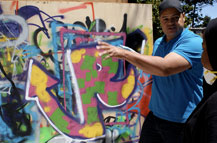Graffiti Arts Program (GAP)
The Graffiti Arts Project (GAP) is a youth prevention and intervention program that teaches graffiti art as a tool for positive self-expression and an alternative to unsafe behaviors. MMAP collaborates with local law enforcement, supported by the United States Department of Justice, Office of Juvenile Justice and Delinquency Prevention, to run GAP. The programʼs curricular focus is artistic skill development, property restoration, and helping youth to utilize their artistic talents for positive expression.
In California, more than 100,000 youth are under the jurisdiction of Californiaʼs juvenile justice system; programs like GAP are effective because graffiti art appeals to youth and is a medium through which young people express themselves. According to Dr. Jessie Whitehead, professor at Southern Connecticut State University, “Graffiti can be a springboard for the examination of personal identity, commercial design, social history and community conflict.” Working with local law enforcement to create works of art featuring graffiti is an excellent way to show youth that adults are listening, are interested, and want to be part of this dialogue for social change. This project-based learning model includes a thematic teaching curriculum exploring the origin of graffiti and demonstrating how youth can express themselves with graffiti without disrespecting the art, others, or the law. GAP reinforces the need to respect other people’s property and to always ask for permission before creating graffiti art.

















